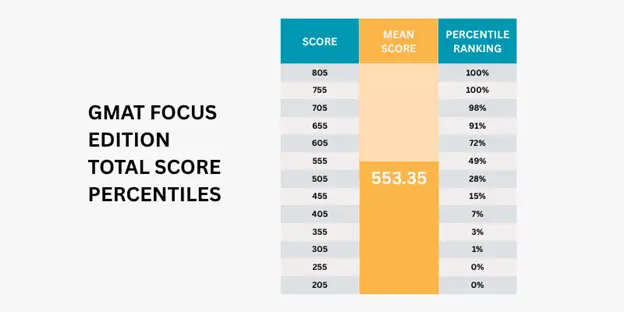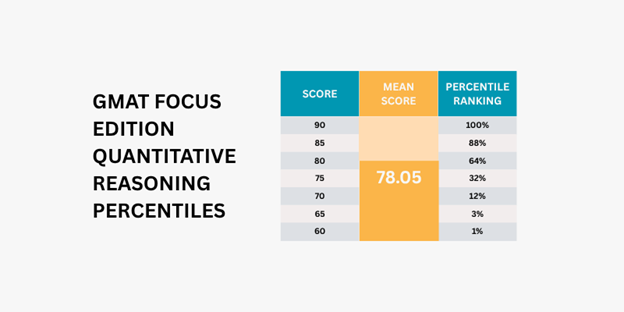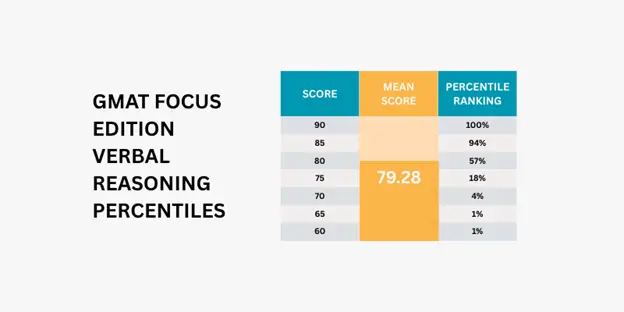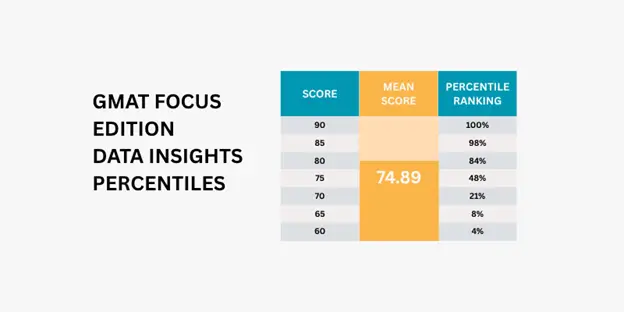What Your GMAT Score Means: Interpreting Percentiles

If you’re gearing up for the GMAT Focus Edition, you’ve probably wondered what your score really means and how schools actually use it.
Getting your GMAT score back is exciting, but just knowing the number doesn’t tell the whole story.
What really matters is how that score compares with everyone else taking the test.
That’s where percentiles come in.
Understanding your GMAT percentile can give you a clearer picture of your chances and help you figure out what a good or competitive score looks like for the schools you’re aiming for.
Let’s break down what your GMAT score means and what you should keep in mind as you plan your next steps.
Overview of the GMAT Scoring System
If you’re familiar with the previous version of the GMAT, the GMAT Exam (10th Edition), you’ll notice that the Total Score scale has changed in the new GMAT Exam (Focus Edition).
This updated scoring helps both you and business schools easily tell which version of the test your score comes from.
Here’s the score comparison:
- GMAT Exam (Focus Edition): 205–805
- GMAT Exam (10th Edition): 200–800
With the shifts in the global test-taking population, Focus Edition GMAT score provides a more balanced way to compare scores, allowing business schools to differentiate performance on the exam.
A 645 on the GMAT Focus Edition corresponds roughly to a 700 on the old exam in terms of percentile ranking, even though the raw numbers look different.
In the GMAT 10th Edition, 700 was the benchmark many aimed for. In the Focus Edition, a 645 carries that same weight.
It’s important to understand that while scores might look lower, they’re not.
The scoring has simply been recalibrated, and business schools are fully aware of this. They focus more on your percentile ranking rather than the raw score itself.
GMAT Score Chart: Total Score vs Percentile Rank
Knowing your total score only gives part of the picture.
Just as important is your GMAT score percentiles, which shows the percentage of test takers you scored higher than.
Percentile ranks put your score into context, helping you understand how competitive it is compared to the scores of everyone else who took the GMAT.
So, what exactly is percentile ranking?
Percentile rankings show the percentage of test-takers you scored better than.
For example, being in the 75th percentile means you outperformed 75% of examinees, and 25% performed better, exactly as GMAC defines it for the GMAT Focus Edition.
Format: The GMAT Focus Edition scoring is based on three sections: Quantitative Reasoning, Verbal Reasoning, and Data Insights. Each section contributes equally to your final score.
What It Measures: The GMAT assesses advanced reasoning and data literacy skills essential for success in today’s tech-driven, data-rich business environment.
Score Range: Total scores range from 205 to 805.
Here’s a GMAT total score breakdown:

Sample Size: 596,155
Standard Deviation: 88.53
Data Period: 2019-2024 (Based on the most recent 3 years of GMAT Focus Edition test-taker data)
Source: GMAC
Interpreting Section Scores (Quant, Verbal, Data Insights)
The section on the GMAT Focus Edition: Quantitative Reasoning, Verbal Reasoning, and Data Insights reflects your readiness for both business school and the modern workplace.
So, how to interpret GMAT score? Here’s a breakdown of GMAT section-wise scores:
1. Quantitative Reasoning
This section tests your understanding of arithmetic and algebra and your ability to apply that knowledge to solve problems.
Format: This section comprises 21 multiple-choice Problem-Solving questions, with a 45-minute time limit.
What It Measures: Your ability to use foundational arithmetic and algebra to solve quantitative problems.
Score Range: Scores range from 60 to 90.
How It’s Scored: Your score is based on these three factors:
- The number of questions you complete
- Whether the answers are correct or incorrect
- The difficulty level and other parameters of the questions you answer

Sample Size: 596,155
Standard Deviation: 6.25
Data Period: 2019-2024
Source: GMAC
2. Verbal Reasoning
This section assesses your ability to read and understand written passages, analyze information, and evaluate arguments.
Format: This section includes 23 multiple-choice questions covering Reading Comprehension and Critical Reasoning, to be completed in 45 minutes.
What It Measures:
- Reading Comprehension questions test your understanding of words and ideas, logical relationships, inferences, and how quantitative concepts are developed in a passage.
- Critical Reasoning questions assess your ability to construct, evaluate, and critique arguments or plans of action.
Score Range: 60 to 90
How It’s Scored: Your score depends on:
- The number of questions you answer
- Whether the answers are correct or incorrect
- The difficulty level and parameters of the questions answered

Sample Size: 596,155
Standard Deviation: 4.59
Data Period: 2019-2024
Source: GMAC
3. Data Insights
The Data Insights section evaluates your ability to analyze and interpret data, draw conclusions, and apply insights to real-world business situations.
Format: This section includes 20 multiple-choice questions to be completed in 45 minutes. You’ll see a mix of question types like Data Sufficiency, Multi-Source Reasoning, Table Analysis, Graphics Interpretation, and Two-Part Analysis. You’ll also have access to an on-screen calculator.
What It Measures: Data Insights tests how well you can read, interpret, and apply data in real-world business scenarios. It’s designed to reflect the growing importance of digital and data literacy, skills that are in high demand across today’s business world.
Score Range: Scores range from 60 to 90.
How It’s Scored: Your score is based on:
- The number of questions you answer
- Whether the answers are correct or incorrect
- The difficulty and other parameters of the questions answered
Some questions have multiple parts, and you must answer all parts correctly to receive credit for that question.
Importantly, your data insight percentile is based on performance data from the past three years of GMAT Focus Edition exams taken.

Sample Size: 596,155
Standard Deviation: 6.03
Data Period: 2019-2024
Source: GMAC
What is a Good GMAT Score?
Everyone wants to know: What is a “good” GMAT score?
Honestly, it depends on where you’re applying and what your overall profile looks like.
Generally, the higher a school ranks, the higher the GMAT scores tend to be for admitted students. On the other hand, schools that rank lower often have more flexible score ranges.
That’s why it’s always a good idea to check the website of your target school to determine the minimum GMAT scores they require for admission to their programs.
Here’s the average GMAT score at the Top Business Schools (data from the 2024 to 2026 class profiles):
| Business School | Average GMAT Score |
| Stanford GSB | 738 (GMAT 10th Edition – The university also accepts the GMAT Focus Edition and will publish the range and average scores as more students take this test.) |
| Harvard Business School | 740 (GMAT 10th Edition – HBS will report GMAT Focus data beginning with the Class of 2027.) |
| Wharton | 732 (This average represents only GMAT scores from the legacy exam.) |
| MIT Sloan | 730 |
| Chicago Booth | 729 |
| Northwestern Kellogg | 733 |
| Columbia Business School | 732 |
| Yale School of Management | 675 (Focus Edition) |
| Tuck (Dartmouth) | 727 |
| NYU Stern | 733 |
Note: While some of these scores are from the earlier 200–800 scale, the percentile benchmarks still align with the new 205–805 GMAT scoring system.
So, if you’re gearing up to apply to a business school, you must know the difference between competitive and safety scores.
A competitive score is one that puts you in the top range of applicants for your dream schools. These scores are usually at or above the average for students who were actually admitted, especially at highly ranked programs.
Whereas a safety score is at or a bit above the average for a program, giving you a higher chance of getting in.
These scores aren’t necessarily your highest possible, but they put you in a good position for schools where you meet or exceed typical admissions numbers.
How Business Schools Interpret Your GMAT Score
Starting in 2024, the GMAT exam got a major update, including changes to how scores are reported.
Because of this, the average GMAT scores schools report are shifting, too.
That’s where percentile rankings come in, as they help you understand how your score stacks up under the new system.
GMAT Focus Edition Score vs Percentile Snapshot
| GMAT Focus Score | Percentile | Interpretation |
| 705 | ~97th | Top-tier applicant |
| 645 | ~89th | Competitive for Top 10 |
| 533 (average) | 50th | Median score (2025 average) |
For example, a score of 645 on the new GMAT Focus Edition is equivalent to a score of 700 on the old version.
So if you’re comparing scores, make sure you’re looking at percentiles, not just numbers.
Thus, business schools don’t just glance at it and move on. They read between the lines.
Here’s how they usually look at your score during admissions:
The Total Score (out of 805 on the GMAT Focus Edition) is usually what schools look at first.
It’s a quick snapshot of your performance. But admissions officers also dig deeper, especially into your Quant, Verbal, and Data Insights scores.
Why? Because they want to see a balanced skill set.
For example, if you have a 705 overall (great!), but your Verbal score is significantly lower than your Quant score, that might raise eyebrows.
A major gap suggests a possible weak spot, and they’ll wonder how you’ll handle reading-heavy or discussion-based parts of the program.
Likewise, a sky-high Quant score won’t save you if your Verbal is weak, and vice versa.
Schools want to admit well-rounded individuals, because that’s what real business challenges require.
And what if you took the GMAT multiple times?
Totally normal. Most people take it more than once.
The good news? Schools usually only care about your highest score (since that’s what they report).
That said, if you’re in the 90th+ percentile, you’re good to go academically for just about any program. If you’re closer to the 50th, the rest of your application needs to really shine.
And if you’re lower than that, it might be worth retaking the GMAT test.
GMAT Score Report: What Schools See
After you take the GMAT, you’ll receive an Official GMAT Score Report
Here’s what actually shows up in your official GMAT Focus Edition score report:
- Total Score and individual section scores for:
- Quantitative Reasoning
- Verbal Reasoning
- Data Insights
- Percentile Rankings for each section and your total score
- Detailed performance insights (by content domain, question type, pacing, etc.)
Your official score report becomes available in your MBA.com account within 3–5 business days after your test and stays valid for five years.
Which Schools See Your GMAT Score?
You control where your scores go.
- You can send your score to five programs for free, anytime within 48 hours after your exam.
- After that, you can send your score to more programs for a fee.
- Only the programs you choose will receive your score.
Remember, GMAC does not automatically send your scores anywhere.
What About Retakes and Cancellations?
GMAC gives you flexibility with retakes and score cancellations:
- Score Preview
After your exam, you’ll see your unofficial score and have 2 minutes to cancel or accept it at the test center.
However, cancellation is also allowed up to 72 hours after leaving the test center if you change your mind later for a $25 fee.
- If You Cancel
Cancelled scores are not visible to schools. Only you can see them in your mba.com account.
- Reinstating a Score
You can reinstate a cancelled score within 60 days by paying a fee. (This option only applies to the GMAT Exam 10th Edition.)
- Retakes
You can retake the GMAT after 16 days, up to 5 times in a rolling 12-month period.
- Multiple Scores
Schools will see only the scores you accept and choose to send, not your entire test history.
Retaking the GMAT to Improve Your Score
Good news—you can retake the GMAT as soon as 16 days after your last attempt, and up to five times in a rolling 12-month period.
That means you’ve got real chances to improve, especially if you focus on fixing weak spots rather than starting from scratch.
Schools care about your highest score, not your average, so every point of progress matters.
But let’s be honest: simply rewatching lessons or grinding more questions won’t cut it.
If you’re aiming for a score jump that actually changes your admit chances, you need more than just content.
You need a smarter study system, one that pinpoints why you’re stuck, shows you how to fix it, and keeps you accountable every time you practice.
That’s where Gurutor comes in.
It’s a self-paced GMAT prep platform designed to act like a GMAT tutor sitting beside you, guiding your approach, correcting mistakes during practice, and providing targeted feedback that builds the right habits.
Remember, taking the GMAT twice, or even more, is normal.
It’s a strategic step, not a setback. And if you’re aiming to give your score a meaningful boost, a well-planned retake can make all the difference.
FAQs About GMAT Scores
What’s the average GMAT score?
The average GMAT Focus Edition score is 553.35, based on the new 205-805 scoring scale. This differs from the previous GMAT (10th Edition), which used a different range and scores ending in zero instead of five.
Is a 700+ GMAT score necessary for top schools?
A 700+ score on the GMAT Focus Edition is highly competitive and puts you in the top percentiles. However, it’s not a must-have for every top business school. Most schools take a holistic view; your GMAT score is a major academic indicator, but they balance it with your work experience, essays, and other credentials.
Can I cancel or reinstate my GMAT score?
Yes, you can cancel or reinstate your GMAT Score:
- Cancel at the center: You have 2 minutes after the exam to cancel for free.
- Cancel later: You can cancel within 72 hours online for a $25 fee.
- Reinstatement: options may vary between the GMAT 10th Edition and the Focus Edition. Check your mba.com account for availability and deadlines based on your test version.
How long are GMAT scores valid?
Your official GMAT score report remains valid for five years from the date of the test.
Can schools see all my past scores?
Schools only receive the scores you accept and send. Also, cancelled scores remain private and are not visible. Most schools consider only your highest accepted score, not an average.
